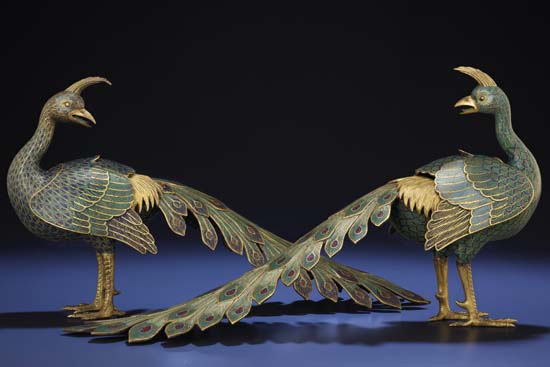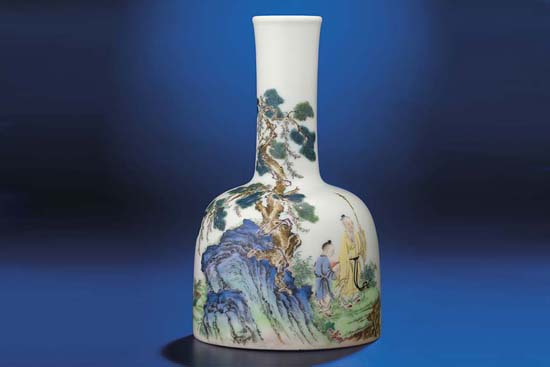Touching Beauty
Hooked on the beauty of Chinese art, CAS alum is respected expert at Christie’s

Athena Zonars does a walk-through of the warehouse rooms tucked away in Christie’s gleaming Rockefeller Center headquarters. It’s a month before one of the auction house’s eight annual Chinese works of art and ceramics auctions, and the senior vice president has recently been named that division’s senior international director.
Zonars (CAS’82) points out a shelf arranged with archaic bronze bowls with earthy iridescent patinas, some of the pieces dating back to 1600 BC. She nestles a delicate water bottle, part of an 18-century Chinese scholar’s desk set, crafted in what she calls a super-rare glaze; its distinctive pale blue is described in Chinese as “sky after rain.” Hundreds of beautiful objects, many with a notable provenance, sit tagged and ready—Ming (1368–1644) and Tang (618–906) dynasty plates, an array of carved white jade figurines, a 12th-century jade bowl. Cradling it as if it were a newborn infant, Zonars runs her fingers over the deep yellow glaze of a vase shaped like a butternut squash. To a nonexpert, it may not look particularly rare or especially Chinese, but it’s an 18th-century imperial vase believed to be one of just two of its kind in existence. At auction it is expected to fetch $1 million.
Having worked at the 250-year-old auction house since an internship in the wine division got her in the door just after graduating from BU, Zonars no longer gasps at dollar amounts. A day earlier at a Christie’s auction of Old Masters paintings, a Botticelli panel once owned by John D. Rockefeller went for $10.4 million, and despite ups and downs in the market over the last decade, 2012 proved to be the house’s most profitable year ever, netting $6.27 billion and setting records at every turn. In 2001, her division set a world record with the sale of a “highly important Massive Bronze Ritual Wine Jar, Late Shang/Early Western Zhou Dynasty,” for a staggering $9,246,000. This is not Antiques Roadshow.
But it’s the beauty of the work that hooked Zonars and has captivated her since Art History 101, a defining moment. The onetime sociology major’s introduction to Asian art was a College of Arts & Sciences course taught at Boston’s Museum of Fine Arts by Vishakha Desai, now president emerita of the Asia Society. “She completely inspired me,” says Zonars, who has become an internationally respected expert in her own right, routinely quoted in the New York Times and other publications.

As anyone who’s ever hefted one of Christie’s lavishly produced catalogs knows, every auction reflects not just stunning works of art, but compelling narratives of the people driven to acquire them. Christie’s authenticates, values, and sells Chinese art to museums and the collectors comprising the small-but-growing world of people passionate about it. Zonars is one of only a handful of people in the world who have risen to a level of respect and confidence that makes her synonymous with the field. The Chinese art sphere is “so broad and so huge,” she says. Her career high point was handling the 700-piece Falk estate collection, which included a 15th-century Ming jardinière, Shang dynasty (1600–1050 BC) bronze wine vessels, and a Song dynasty (960–1279) celadon bowl. “I’m still finding great works of art to sell,” she says. She may view 150 possible auction items in a day and must decide of each: Is it a good representative of its type? Has it retained its integrity? Has it been restored, which could lower its value?
In putting sales together, Zonars says, “my job is to do three things: I have to find out what’s out there, I assess the market conditions, and I need to determine of each piece, is it worthy?” Very rarely, a valuable piece may surface in someone’s attic, but Zonars mostly handles collections that have been amassed meticulously and ardently, collections like those of the late Pauline and Myron Falk, beloved in the Chinese art world and admired by Zonars since she toured their majestic home as a student.

Her calling embraces all the senses, especially touch. “It’s a tactile art,” says Zonars, who despite her travels in a gilded universe is unpretentious. On her climb up the Christie’s ladder, she did a stint in the warehouse, where she learned the importance of handling the work. “Weight is a big thing,” she says. “You know after holding a dish” if it’s an authentic Ming dish or Ching (1644–1912) vase. She studies “the way the light hits a glaze, the way the object has weathered—its abrasions, cracks, the chipping, the patina, the crackling, the way something is discolored, or when you see really good, honest scratching. I’m not a doctor, but what we do is similar. He looks at a patient and knows right away what’s wrong; he’s seen 400 cases.”
Christie’s Asian division has semiannual auctions of Chinese works of art in New York, Paris, London, and Hong Kong, and Zonars attends them all. The auctions proceed as they do in the movies, except that the auctioneer speaks slowly. “It’s not a cattle auction, and he wants everyone to know what’s going on,” says Erin McAndrew (GRS’96), Christie’s vice president and head of communications for the Americas. “And the auctioneer doesn’t say, ‘Going, going, gone,’” adds Sung-Hee Park (CAS’02), associate vice president and public relations manager, who sometimes works the auctions taking phone bids. In addition to the traditional raising of paddles, preauction absentee bids, and bids called in from around the world, 20 to 25 percent of bids are now placed online, and the auctioneer must keep track of all of these while keeping a close eye on the paddles. Bidding wars can last up to six minutes. McAndrew recalls Christie’s agreeing to retract just one bid, by an online bidder who claimed her cat jumped on the keyboard.
Errant cats and tight production deadlines notwithstanding, the process is impressively smooth, auction after auction. “There’s great excitement, there’s risk, there’s competition,” says Zonars. “Every collection is different.”
A version of this story was originally published in the spring 2013 edition of arts&sciences magazine.
Comments & Discussion
Boston University moderates comments to facilitate an informed, substantive, civil conversation. Abusive, profane, self-promotional, misleading, incoherent or off-topic comments will be rejected. Moderators are staffed during regular business hours (EST) and can only accept comments written in English. Statistics or facts must include a citation or a link to the citation.